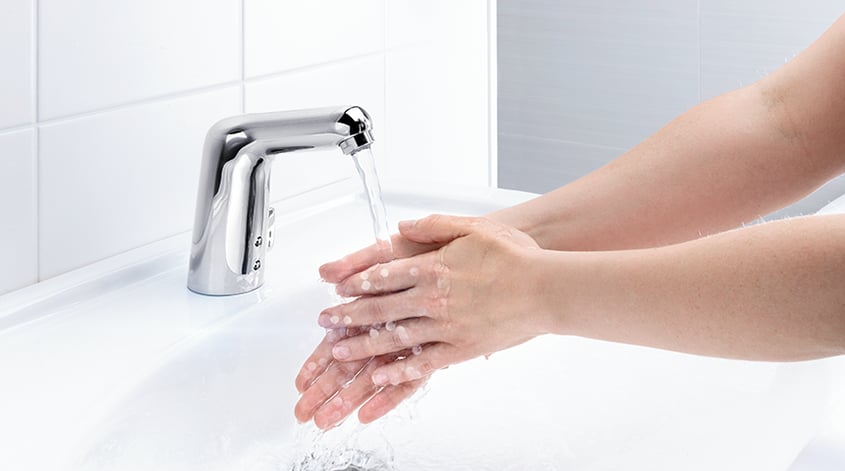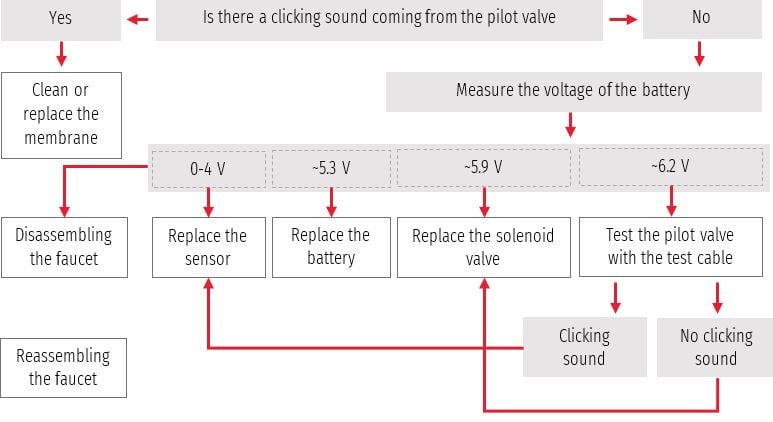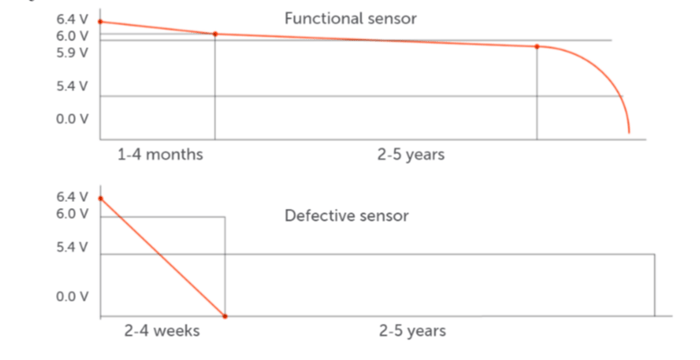Fixing a touchless faucet? It’s not always easy to identify the problem. Here’s how to navigate the four most common maintenance issues.

1. The water is not running from the faucet
Is there a clicking sound coming from the pilot valve?
If YES, the problem is most likely in the membrane of the solenoid valve. Cleaning or replacing the membrane should solve it.
If NO, consider these possibilities:
- Measure the battery voltage. If it is very low (0-4V), a short circuit in the sensor or the cable is causing excessive power consumption.
Replace the sensor as a faulty sensor could exhaust the battery in a few weeks when it should last many years.
- If the battery voltage is below 5.4 to 6.4V, the battery is flat.
Replace the battery with a new one. (Normally, it should last 2-5 years.)
- If the battery voltage is below 5.9V and water is not running from the faucet, the pilot valve is clogged due to dirt or debris. A voltage below 5.9 is not enough to open or close the pilot valve, so the faucet cannot operate.
Replace the solenoid valve. (Note: It is not possible to replace the pilot valve alone, but the whole solenoid valve needs to be replaced.)
- If the battery voltage is fine and close to the voltage of a new battery (~6.2V), the operation of the pilot valve should be tested with the test cable.
- If the pilot valve is making a clicking sound while testing it with the test cable, the sensor is faulty and needs to be replaced (as in case A.
- If the pilot valve is not making a clicking sound, the pilot valve is faulty, and the entire solenoid valve needs to be replaced.
 Troubleshooting chart for Oras Electra touchless battery operated faucet
Troubleshooting chart for Oras Electra touchless battery operated faucet
2. The water flow does not stop
If dirt or impurities in the water enter the pilot valve or reach the pilot valve membrane, this can cause leaking. Cleaning the membrane or replacing the pilot valve will solve the problem. To avoid leaking faucets, it is important to install one-way valves and litter filters supplied with the faucet.
3. The sensor has a red blinking light
This means the battery is flat and needs to be replaced.
4. The batteries run out quickly
In this case, the sensor is most likely faulty, causing excessive power consumption and draining the battery. Replacing the sensor will fix the issue.
With a functional sensor, the batteries normally last several years. To change the sensor, you need to disassemble the faucet. See how here.
 With a functional sensor, the batteries normally last several yes. With a faulty sensor, the batteries can run out in a matter of weeks.
With a functional sensor, the batteries normally last several yes. With a faulty sensor, the batteries can run out in a matter of weeks.
If this guide didn’t help you solve your touchless faucet problem, please contact our technical service experts. They’re always there to help.






 Troubleshooting chart for Oras Electra touchless battery operated faucet
Troubleshooting chart for Oras Electra touchless battery operated faucet With a functional sensor, the batteries normally last several yes. With a faulty sensor, the batteries can run out in a matter of weeks.
With a functional sensor, the batteries normally last several yes. With a faulty sensor, the batteries can run out in a matter of weeks. 